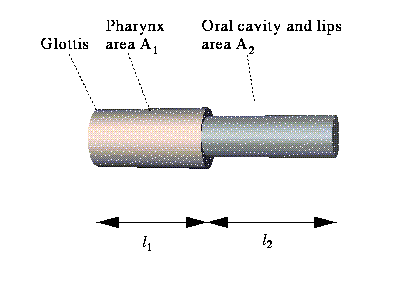| Vocal
tract profile of natural (British English) [ |
Model of
a vowel like [ |
![[ah] vocal tract profile](part-vowel1.jpg) |
|
1. Purpose. Perspex tube models allow us to get a practical (as opposed to theoretical) understanding of resonance, resonant frequencies (formants), the source-filter model and some aspects of the relationship between articulatory configurations and their acoustic consequences.
2. Idealizations. Plastic tubes are unlike real vocal tracts in many ways, e.g. i) straightness, ii) uniform cross-sectional shape, iii) rigidity, iv) the material from which they are made. These things have small effects on the sound produced, so we won?t bother about them. Changes in the length and/or (sometimes) the cross-sectional area have a greater effect on the sound produced. Also, we shall use electronically generated sine waves, rather than a sound like that produced by the larynx, as the input to the tubes.
3. In tubes with a uniform cross-section, sound waves will resonate at those wavelengths which relate to the length of the tube in such a way as to be reflected backwards and forwards from one end of the tube to another. The signal at the output of the tube is louder at resonant frequencies and quieter at non-resonant frequencies. The cross-sectional area of the vocal tract is, in fact, almost uniform for a schwa. For a typical adult male, the length of the vocal tract l is approximately 17 cm.
What are the resonant frequencies of the tube with length 17 cm and area 4.52 cm2? (Acoustic theory says that the first four resonances should be found at 500 Hz, 1500 Hz, 2500 Hz and 3500 Hz.) What happens if a) the area is reduced to 3.3 cm2? b) the length is reduced to 15 cm? (Note that practical measurements of F1 seems to be very inaccurate in our set-up, perhaps because of the acoustic properties of the headphone loudspeaker.)
4. Some vocal tract shapes can be approximated by connecting together two or more uniform tubes with different cross-sectional areas.
| Vocal
tract profile of natural (British English) [ |
Model of
a vowel like [ |
![[ah] vocal tract profile](part-vowel1.jpg) |
|
| 5.
|
Vocal tract profile of natural (British English) [i] | Model of a vowel like [i]. |
![Vocal tract profile of [i:]](peat-vowel1.jpg) |
 |
6. Uniform vocal-tract shape with rounding (a very rough approximation to the vowel [u]). Typical values are l1 = 15 cm, l2 = 2 cm, A1 = 5 cm2, A2 = 0.3 cm2. In our tube model, A1 = 4.52 cm2 and A2 = 0.5 cm2.
| Vocal tract profile of natural (British English) [u] | Model of a vowel with lip rounding, a little like [u]. |
![Vocal tract profile of [u:]](uu-high-rev.jpg) |
 |